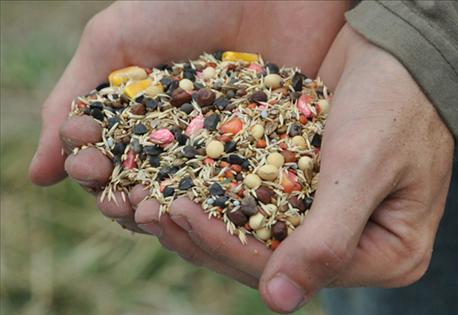July 29, 2016

He's an educator who loves to learn.
And when it comes to his soil-health-centric farming approach, Mike McDonald admits he doesn't mind making a mistake or two along the way, as long as he learns something in the process.
"As I have learned from other people, I realize there is so much out there — that I am just making mistakes," he says. "But I'm trying to make educated mistakes. I'm trying to get to value out of those mistakes," he says.

BUILDING SOIL RESILIENCY: Janet and Mike McDonald, and farm assistant Riley Porter (center) of Palmyra, are focusing on soil health management systems to improve the production capacity and resiliency of their farm. (Photo credit: Ron Nichols)
McDonald, 55, and his wife, Janet, farm nearly 200 acres near Palmyra. Both were raised on family farms, so after wrapping up his 30-plus-year career as a K-12 educator and university professor at Nebraska Wesleyan University, the McDonalds have fully immersed themselves into farming — sustainably.
McDonald's cropping system currently includes conventional, non-GMO row crops (including high-moisture corn); and barley, wheat and mixed species cover crops and pastures. And although he doesn't currently own a herd, he's incorporated cattle into his farming operation, both for the income from tenant grazers and for the soil health and nutrient cycling benefits the cattle bring to the farm.
"I've tried to get beyond the corn-soybean traditional rotation," McDonald says. "I know it's cliché, but I'm trying to go back the way it used to be in terms of Mother Nature. We're trying to reconvert this back to native forbs, annuals, perennials," he says.
His farm's trek to sustainability is already yielding some surprising, often noisy, results.

PLANT DIVERSITY: The selection of multiple cover-crop and pasture plant species is improving soil health and the overall production capacity of the Mike McDonald farm near Palmyra. (Photo credit: Ron Nichols)
"If you go out among the trees," McDonald says, pointing to an area reserved for pollinator habitat near a small pond, "and stop and listen, it literally it sounds like the trees are going to fly away because there are so many bees in them."
Through NRCS' Conservation Stewardship Program and the Sustainable Agriculture and Research Education Program, McDonald has been able to establish that pollinator habitat; and he's also been able to more fully develop his soil health management system through the use of no-till, diverse crop rotations and cover crops.
And while many farmers measure success by bushel outputs, McDonald also includes the cost of inputs in his financial analysis. "We are trying to reduce, to hopefully not use, herbicides. I'm not organic, but I'm trying to manage by using different cropping rotations," he says.
Part of his farming approach includes managing risks like weather volatility by using continuous cover crops. The cover crops help capture and retain moisture for those periods of extended dry weather that add stress to both the crop and to the farmer.
"Utilizing a mixture of cool- and warm-season cover crops, particularly legumes, helps us capture moisture when it is there — and reduce stress if it doesn't rain, or if I'm going to have a crop," McDonald says.
And he sees no-till as the cornerstone of sustainability on his farm.
"I truly believe if you are going to build your soil you can't open up wounds. I know we look at the residue, but the more I learn, the more I realize it's the liquid carbon below the ground that is equally or more important than what's aboveground," he says. "Several friends have called it the 'iceberg effect.'"
The consummate educator, McDonald's farm is also a living classroom — a center of learning for himself, his fellow farmers and his fellow consumers. A Conservation Innovation Grant from the NRCS in Nebraska has not only helped McDonald create that classroom, but it has also connected him with 39 other "learning cohorts" (producers) from across the state, as well as others who are interested in sustainable agriculture.
"We all want to know where our food comes from. I do," McDonald says. "Everybody wants to know. How we work together, how we educate — that all has to be purposeful, it has to be intentional. As farmers we can't just say 'Well, I'm going to use cover crops with my cash crops.' At the end of the day, it has to be about working, communicating, educating."
"It's incredibly rewarding to work with farmers like Mike," says Mike Burgert, NRCS resource conservationist. Burgert has worked with McDonald over the years and has seen firsthand the devotion of the farmer and the evolution of the farm.
"Mike is always interested in learning more about soil health and sustainable farming, and he's equally willing to share his experiences with others," Burgert says.
In fact, the McDonalds are so committed to the future of sustainable farming and to the need for continuing education that they hope to place their farm in a land trust, so that their legacy of growing, learning and teaching will live on for generations to come.
"I have learned so much from others," McDonald says. "So we intend to protect it [the farm], so that others can learn about sustainability, too."
Nichols is public affairs officer at USDA's Natural Resources Conservation Service.
You May Also Like




